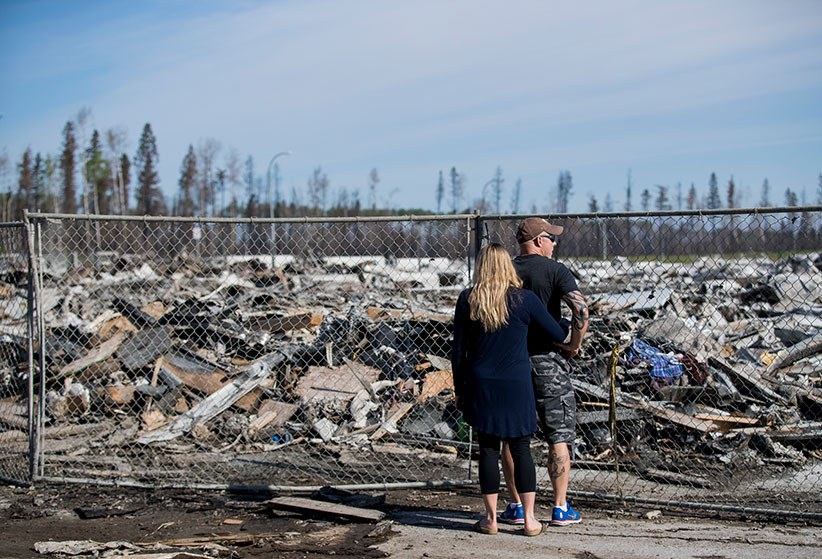When the cartoon Fort McMurray finally burned down
Fort McMurray has survived the wildfire. The same cannot be said for the boozy, raucous stereotype that dogged it for years.
In a photo provided by the Canadian military, smoke from a wildfire billows over a neighborhood of Fort McMurray, Alberta, Canada, May 4, 2016. (Mcpl Vanputten/Canadian Armed Forces)
Share

It’s still too soon to tell if last May’s wildfire has permanently changed Fort McMurray—there are homes yet to rebuild and mental scars to heal, and the continued economic churn in the oil sands may prove the dominant author of the city’s narrative. But one lasting change is easier to declare, and has applied since May 3, 2016: outsiders’ understanding of Fort McMurray is forever transformed. It’s sad it took the most damaging natural disaster in Canadian history for many of us to see the true character of the country’s most economically significant small city, but what’s done is done.
Also in the rear-view are the litany of national and international stories that obsessed over the get-very-rich-very-quick excesses of the oil sands capital. One after another, fly-in journalists would pop into the Boomtown Casino and the strip club—with perhaps a detour to the Salvation Army emergency shelter—on their way up north to tour an oil sands plant or work camp, and usually onward to meet with First Nations leaders concerned by the pace and destruction of it all. Environmental groups would sometimes bemoan the state of the social fabric (frayed, in their eyes, or non-existent) as part of their demonization of all things tarry and sandy in Alberta.
Often absent from the picture were the young families and longtime residents (save the occasional oldtimer concerned by the pace of it all). Why this omission, which was so greatly irritating to the locals? Because any other city has families; we tend to highlight what makes it extraordinary, not ordinary.
This is why the growing population of ordinary denizens tended to fly under the public imagination—that is, until outsiders were shown wildfire evacuation centres teeming with Fort McMurray’s youth and bedraggled parents, disoriented immigrant couples and teenage girls looking for prom gowns among the thousands donated for their perusal. These family-next-door images deepened Canadians’ compassion for those thrust from their homes temporarily or permanently. If they’d borne any resemblance to those hoary stereotypes—if all that popped up on TV news were a bunch of overpaid millennial electricians treating the disaster like an extended vacation—that gusher of Red Cross donations might have been less intense. In reality, Canadians recognized those evacuees because they looked a lot like their own neighbours and cousins.
READ MORE: Why Fort McMurray will never be the same
If the spilled-out populace of Fort McMurray looked much like that of every other Canadian city, that’s in part because its inhabitants come from every other Canadian city. The proportion of McMurrayites whose mother tongue is French is substantially higher than that of Metro Vancouverites. Ditto for Spanish, Bengali, Arabic and Somali—opportunity’s lure had made it a quintessentially diverse Canadian city.
The community had done some maturing since the peak of the boomtown frenzy. Children of the last boom had grown up and were having kids of their own, and families were increasingly moving here along with the single labourers. Thanks to an accelerating birth rate, children and minors made up 21.7 per cent of Fort McMurray’s population by 2014, not far off the 22.2 per cent Alberta average, according to one provincial report. And it’s the families who are proving most resilient in post-wildfire Fort Mac: while the overall population is down by double digits, public-school enrolment is down by just five per cent while the student population at the city’s Keyano College has remained steady.
There’s another reason those boomtown freak-show stories won’t be coming back. The boom may not return, with low oil prices persisting and the last of the mining megaprojects nearing completion. Fort McMurray seems destined for a prolonged period that ebbs more gradually from no growth to some growth to gradual decline. As the rebuild proceeds and normalcy returns, the narrative will be less exceptional; residents may appreciate the lack of outsiders peering in and pronouncing. Maclean’s last look at the city’s recovery and economic fortunes raised hackles locally for highlighting one young electrician who despaired, among other things, the lack of things to do other than bar drinking. That line picked an old scab, one leaders and residents have long bid to heal with a massive new recreation complex, a burgeoning arts scene and popular local sports clubs. They’ll readily admit there’s not as much on offer as in Edmonton or Calgary but, by golly, it’s better than it used to be.
When Fort McMurray reopened to residents last June, Canada again saw the city’s families, relieved and recovering, starting the long work of restoring their community. Visiting reporters can still find the peeler bar and pub table of young, cocky Newfoundlanders or Maritimers. But they know better than to mistake that for the true face of Fort McMurray.

